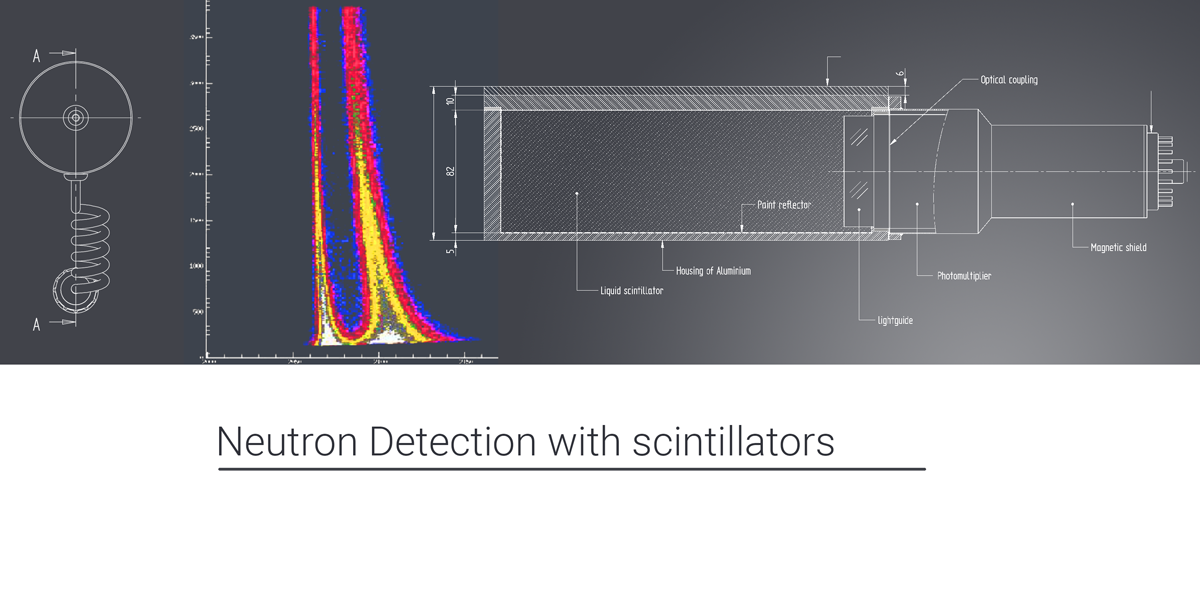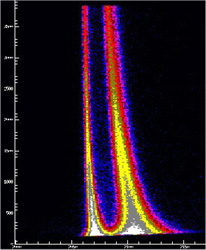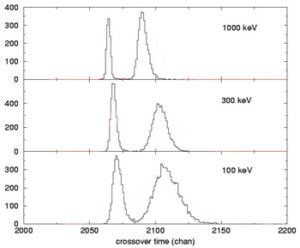
Neutron detection with scintillators
In general neutrons are more difficult to detect than gamma rays because of their weak interaction with matter and their large dynamic range in energy.
Fast Neutrons can interact with materials that contain a large concentration of hydrogen atoms (protons), for example, organic materials, by means of elastic scattering in which case the energy of the neutron is (partially) transferred to the protons which on their turn can produce scintillation light. Using the above principle, fast neutrons can be detected in any organic (plastic or liquid) scintillator.
The efficiency of neutron absorption in a liquid scintillator can be increased by adding 0.5% by weight of Gadolinium to the liquid.
In some liquid scintillators, fast neutrons produce scintillations with different decay times for neutrons and gammas. Using Pulse Shape Discrimination (PSD) techniques, it is, therefore, possible to separate fast neutrons from gammas. Special design considerations are important in the design of liquid cells for this application.


Thermal neutrons produce a continuous spectrum in organic scintillators.
Thermal neutrons can be detected by means of a nuclear reaction with 6-Li atoms in 6-Li containing scintillation materials. In this reaction, a triton and an alpha particle are produced. An example of such material is Ce-doped 6-Li glass. It is possible to have enrichment up to 96% of 6-Li in this scintillation material.
In order to detect fast neutrons with a 6-Li containing scintillation material, the neutrons must be first moderated with a suitable (hydrogen rich) material, for example, a plastic.
Thermal neutrons produce a peak in Ce-doped Li glass scintillators at a gamma equivalent energy of approx. 1.9 MeV. Another technique to measure the energy of fast neutrons uses time of flight measurements which consists of an accurate determination of the moment of interaction between the neutron and a fast plastic scintillator. In general, several meter long scintillation plastics are used for these experiments.
Summary
Fast Neutrons:
- Detected in hydrogen-rich organic scintillators.
- Continuous spectrum.
- Neutron/gamma separation by PSD.
- Significant absorption volume required.
Thermal Neutrons:
- Detected in 6-Li containing scintillation materials.
- Produce thermal neutron peak in the energy spectrum
- 3 mm thick of 96% enrich ed 6-Li glass will stop 90% of thermal neutrons
Related products:
CLYC
(CLYC) is the first practical gamma-neutron scintillation detector for use as a replacement for both medium resolution gamma-ray detectors and Helium-3 proportional counter tubes for neutron detection.
CLLBC
Dual-mode CLLBC crystal offers an ideal solution for applications that require high-resolution gamma spectroscopy and Neutron detection in one scintillator.

